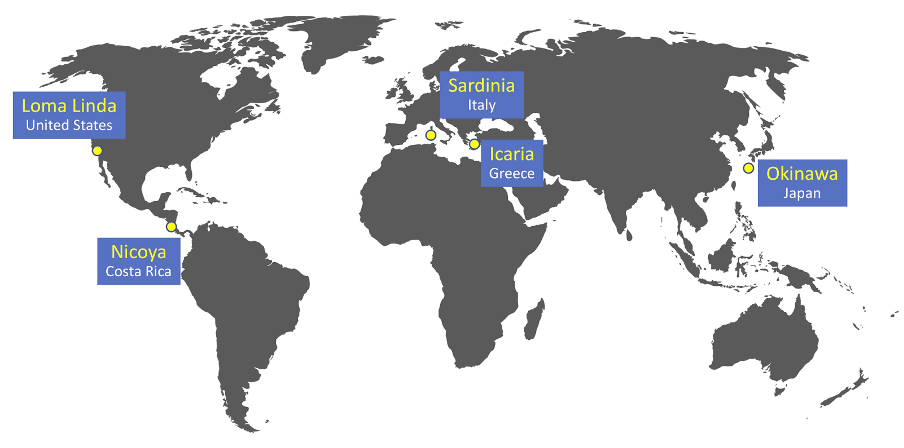Imagine if we could take the healthiest people in the world and ask them for all of their secrets? Lucky for us, somebody did exactly that! Call it a map of longevity, or the “blue zones”, representing global health hot-spots – places where people live the longest without chronic illness.
The concept of blue zones originated from researchers Gianni Pes and Michel Poulain, who identified the Italian Island of Sardinia as an impressive hub of good health. This was built on later by Dan Buettner to include four other regions with equally impressive longevity.
As they dug deeper, these researchers began to identify common themes across the 5 blue zones. These themes involved things across all realms of health, including nutrition, social connection, belief systems and of course – movement! Being exercise physiologists, we want to know… What did they have to say about movement?
Move Naturally
When the majority of us consider an effective exercise regime, our minds go straight to structured exercise. A layout that might consist of say, 2 x resistance sessions and 2 x cardio sessions across the week. What if we told you that of the top fifteen exercise modes identified in the blue zones, zero involved a gym. . . In fact they involved very little structure at all!
Instead of engaging in physical activity in a structured way, like many of us do, research shows that people in these wellness hot-spots take a more natural approach to movement. It fills pockets of their day-to-day, in the way of active hobbies, meaningful work and household chores.
Now, we’re not saying “scrap your gym program”. This new information might simply inspire you to reconsider that rigorous 6 x per week training regime and make space for some natural movement too. This is especially useful if fitting in structured exercise isn’t appealing, or realistic for you.
Get Outdoors
Talk of a “green prescription” are becoming more common in the health and wellness space. It has been identified that spending time outdoors, ideally in nature, has a host of benefits for both physical and mental health. This concept is backed by those in the blue zones also. Luckily for us, physical activity and the great outdoors go hand in hand.
The physical activity taking place in these environments is primarily outdoors. Outdoor hobbies such as hiking and horseback riding, household tasks such as gardening, and many professions that are outdoors like farming and agriculture. Importantly, walking was found to be the second most popular mode of activity! How empowering is that; something as simple as stepping out of the front door and putting one foot in front of the other, can have an array of benefits for your physical and mental health.
An opportunity to connect
Although not obviously related to physical activity, here at Specialised health we are well aware of the social opportunities that physical activity provides us with. For this reason, connection is something we consider in our customers programs.
In the blue zones, connection with others was identified as a significant contributor to long-term health. It involved spending time with loved ones and finding a sense of belonging. If you ask us, physical activity is a fantastic way to do this!
Looking again at your exercise regime (now slightly altered to allow for more natural movement we hope), can you spot any opportunities for connection? Whether that’s getting out for a walk with your partner, swapping a solo gym session for a group class, or even engaging in your favorite physical hobby with friends next time you’re due for a catch up.
Simplicity is Key
If there’s one thing you take away from this article, let it be not to overcomplicate things.
“Fitness” can be wildly over-complicated, but at the end of the day, move naturally, preferably outdoors, and even better if with loved ones!
References
- Buettner, D., & Skemp, S. (2016). Blue Zones. American Journal of Lifestyle Medicine, 10(5), 318–321. https://doi.org/10.1177/1559827616637066
- Herbert, C., House, M., Dietzman, R., Climstein, M., Furness, J., & Kemp-Smith, K. (2022). Blue Zones: Centenarian Modes of Physical Activity: A Scoping Review. Journal of Population Ageing. https://doi.org/10.1007/s12062-022-09396-0
- Thompson Coon, J., Boddy, K., Stein, K., Whear, R., Barton, J., & Depledge, M. H. (2011). Does Participating in Physical Activity in Outdoor Natural Environments Have a Greater Effect on Physical and Mental Wellbeing than Physical Activity Indoors? A Systematic Review. Environmental Science &Amp; Technology, 45(5), 1761–1772. https://doi.org/10.1021/es102947t
Author: Tessa Nielsen Editor: Yolanda van Vugt Clinical Exercise Physiologist and Content Creator at Specialised
#exercisephysiology #exerciserehab #rehabilitation #lifeinsurance #incomeprotection #ctp #workcover #mobile #mobileexercisephysiology #fatigue #mentalhealth #cancer #musculoskeletal #injury #pain #physio #physiotherapy #Sydney #Brisbane #Melbourne #Adelaide #Auckland #Waikato #BayofPlenty #Wellington #Otago #Christchurch
